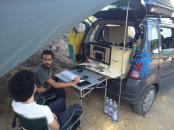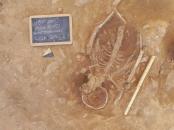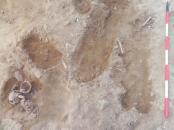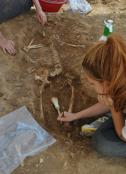CAMPAGNA 2015 |
1° SETTIMANA |
2° SETTIMANA |
3° SETTIMANA |
4° SETTIMANA |
5° SETTIMANA |
6° SETTIMANA |
29 GIUGNO 2015 
Resoconto della giornata di scavo
Generale
Da oggi e per tutta la settimana la troupe di videoreporter Bird Peak capitanata dal regista Federico Gusso seguirà l'evoluzione dello scavo di Badia Pozzeveri con due dirette streaming alle 11 ed alle 16. Seguiteci sul nostro portale e sul sito Bird Peak!
Area 2000
Terminata la documentazione dei due individui esposti.
Usk 2537 nella porzione centrale dell’allargamento è un giovane adulto di sesso femminile, deposto supino in fossa terragna semplice; gli arti superiori sono asimmetrici in quanto il destro è disteso lungo i fianchi mentre il sinistro è leggermente flesso sull’addome. La lassità generale delle connessioni, la rotazione laterale dell’omero destro e una lieve disconnessione della mandibola fanno credere che la decomposizione sia avvenuta in spazio parzialmente vuoto, a causa della presenza di una veste o un sudario.
Usk 2519 è un individuo adulto di circa 45-50 anni di sesso maschile, deposto prono e decomposto in spazio pieno. L’arto destro risulta flesso sul torace e si osserva una fusione delle ultime vertebre lombari.
Altri due tagli sono stati individuati nell’angolo Nord Orientale dell’allargamento. Il primo (US -2540) è orientato Est Ovest ed è stato disturbato sia ad ovest che ad est; ciò ha compromesso la conservazione dello scheletro di cui è stato rinvenuto solo parte del piede sinistro (il calcagno, i metatarsi e alcune falangi).
Subito a Nord, US -2543 avente stesso orientamento e forma più regolare ellissoidale non sembra, ad una prima osservazione, un taglio sepolcrale; all’interno il riempimento è caratterizzato dalla presenza di molti inclusi litici e lastrine di piccole e medie dimensioni e al momento della rimozione sono state rinvenute alcune ossa sparse, due chiodi e alcuni grani di rosario blu.
La situazione stratigrafica in questa porzione del settore appare quindi molto complessa e risulta interessante notare come degli individui documentati si conservino esclusivamente i distretti inferiori; si potrebbe ipotizzare che si tratti di rideposizioni post-mortem in appositi tagli sepolcrali quando ancora perduravano i tessuti molli.
The site was uncovered and work began immediately. The visible cut -2540 was explored and found inside were left tarsal bones which were given the number USK 2541. Fill US 2542 was then removed, photos and GIS points were taken.
Exposed USK2519 further and finally removed the remainder of the prone skeleton and documented the second part of the skeleton. Age of USK2519 was hypothesized between ~30-50 years of age. We uncovered 2 grave cuts in the northeastern part of the western expansion including -2540, -2543 began removing the fill (US 2544) which included a partial skull, diaphysis fragment, teeth and a small bead. Photos and GIS points will be taken in the morning. USK 2537 was completely revealed today and determined to be female due to a smaller mastoid process and overall petiteness of the bones. USK 2537 was removed and cataloged. The fill (US 2535) was also removed and contained miscellaneous bones, brick and stones. Skeletal context sheets were filled but tomorrow the cut and fill context sheets will be done. GIS points and photographs were taken of USK 2537 and USK 2519.
Area 3000
La seconda settimana di scavo si è aperta con la messa in luce completa dell’inumato USK 3546, orientato W-E e deposto in decubito dorsale all’interno della fossa sepolcrale US – 3541, nella porzione nord-orientale del Settore B. Si tratta di un maschio adulto complessivamente in buono stato di conservazione, ad eccezione del cranio, leggermente in norma laterale destra, che risulta frammentato; gli arti superiori sono entrambi leggermente flessi sul bacino, con la mano destra in corrispondenza del sacro e sovrapposta a quella sinistra, appoggiata sul coxale destro. Gli arti inferiori sono entrambi distesi, con le caviglie chiuse ed i piedi ravvicinati. A giudicare dall’analisi tafonomica si può dedurre che l’individuo sia stato sepolto originariamente all’interno di una cassa lignea, probabilmente di forma antropoide (più larga in corrispondenza delle spalle e più stretta ai piedi). Nella porzione centro-meridionale del settore continua la messa in luce dello scheletro USK 3544, orientato S-N e deposto supino in US – 3535; più ad ovest è iniziata inoltre l’indagine del taglio ellittico US – 3547, orientato SE-NW, riempito da un sedimento argillo-limoso pieno di frammenti di laterizio, scisto, pietre di piccole e medie dimensioni e numerose ossa per il momento non in connessione anatomica.
Today in Area 3000 we continued excavation on skeleton 3544. We uncovered the skull as well as much of the left side of the body including the left ox coxa, the left femur, and the left tibia. We also continued to uncover the upper part of the torso and located the skull. The skull appears to be turned sideways and has been pressed down, separating the upper portion of the skull from the lower. We hope to have the entire skeleton uncovered by the end of tomorrow. We also finished excavating 3543 and began on a grave, only to reveal a head, hand, and the beginning of two legs. In the northeast section of area 3000B we completed excavation of USK 3546. Following the excavation 3D restoration photos and GIS measurements were taken. Skeletal context and stratigraphic context sheet have been filled out. Currently we are in the process of exhuming the body and will continue the process tomorrow.
Ricostruzione 3D dello scheletro USk 3546
Area 5000
Nella giornata di oggi è cominciato la scavo della US 5133, uno strato a matrice mista ricca di materiale lapideo e frammenti di laterizi che ricopre la porzione Ovest dell'area. Si è proceduto inoltre con la rimozione di US 5152, il riempimento di una fossa di spoliazione lunga circa 8 m e larga 60 cm, orientata in senso Nord-Sud e posizionata nel centro dell'area di scavo. Sarà molto interessante nei prossimi giorni, capire quali sono i rapporti stratigrafici di tutte le strutture murarie emerse, così da stabilire un ordine cronologico utile a fornire informazioni riguardo le fasi di vita dell'abbazia.
Today in area 5000 we began by continuing to pick axe the front one third of the area, approximately 5 inches down. During this process we found small fragments of animal bone, pottery, and glass; the last of which we estimate to be from a seventeenth century decorative object. GIS points were taken on farthest south portion of the older wall that had been excavated over the past few days. The larger area was trowelled and cleaned. And a small depression in the older wall was investigated and cleaned to understand the depth of an area that was unusually sandy. One person was sent to GIS lab, another to material cultures, and two were spent to archaeospelology over the course of the day.
Area 6000
Con la giornata odierna è stata quasi terminata la messa in luce della trincea US -6007 e relativa rimozione del riempimento US 9002. Sui margini longitudinali della suddetta trincea stanno venendo messi in lucequelli che sembrano dei tagli intercettati, ai primi del XX secolo, dalla suddetta opera di drenaggio. Successive indagini permetteranno di capire la natura ed origine di tali buche (allineate sull'asse est-ovest).
Much like the later half of last week, Area 6000 continued to work in the trench. Unlike last week though, we worked to define the interface between the 20th century trench (6002) and the Medieval sections (6001 and 6003) with trowels and brushes. During the day we uncovered two highly weathered and mostly fractured skulls. However, these skulls were not located in Area 6002, but are a part of the Medieval section 6001 and were aligned unconventionally. Additionally, we found dozens of pottery sherds that were out of context. Tomorrow, we hope to continue defining the cut with trowels.













